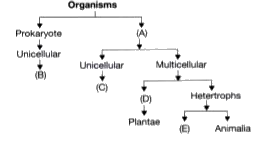Assertion (A): Bacteria come under prokaryotes.
Reason (R): They lack a well-defined nucleus.
Both A and R are true, but R is the correct explanation for A.
Both A and R are true, but R is the not the correct explanation for A.
A is true and R is false.
A is false and R is true.
The correct Answer is:A
Step-by-Step Solution:
1. Understanding the Assertion: The assertion states that "Bacteria come under prokaryotes."
- Explanation: Prokaryotes are organisms that do not have a membrane-bound nucleus. Bacteria are classified as prokaryotes because they fit this definition.
2. Understanding the Reason: The reason states that "They lack a well-defined nucleus."
- Explanation: Bacteria indeed lack a well-defined nucleus. Instead of having a nucleus that is enclosed by a membrane, their genetic material is found in a region called the nucleoid, which is not membrane-bound.
3. Connecting Assertion and Reason: Both the assertion and reason are correct statements about bacteria.
- Explanation: Since bacteria are classified as prokaryotes due to their lack of a well-defined nucleus, both statements are true.
4. Evaluating the Explanation: While both the assertion and reason are correct, the reason does not fully explain why bacteria are classified as prokaryotes.
- Explanation: The reason is true, but it does not provide a comprehensive explanation of the classification of bacteria as prokaryotes. Therefore, while both statements are correct, the reason does not adequately explain the assertion.
5. Conclusion: Based on the analysis, the correct option would be that both the assertion and reason are correct, but the reason does not correctly explain the assertion.
Final Answer:
Both the assertion (A) and reason (R) are correct, but R does not explain A.
---
- Explanation: Prokaryotes are organisms that do not have a membrane-bound nucleus. Bacteria are classified as prokaryotes because they fit this definition.
- Explanation: Bacteria indeed lack a well-defined nucleus. Instead of having a nucleus that is enclosed by a membrane, their genetic material is found in a region called the nucleoid, which is not membrane-bound.
- Explanation: Since bacteria are classified as prokaryotes due to their lack of a well-defined nucleus, both statements are true.
- Explanation: The reason is true, but it does not provide a comprehensive explanation of the classification of bacteria as prokaryotes. Therefore, while both statements are correct, the reason does not adequately explain the assertion.
Both the assertion (A) and reason (R) are correct, but R does not explain A.
Topper's Solved these Questions
- BASIS OF CLASSIFICATIONBook:PEARSON IIT JEE FOUNDATIONChapter:BASIS OF CLASSIFICATIONExercise:MASTERING THE CONCEPTS (Knowledge and Understanding)
Explore 7 Videos
- BASIS OF CLASSIFICATIONBook:PEARSON IIT JEE FOUNDATIONChapter:BASIS OF CLASSIFICATIONExercise:MASTERING THE CONCEPTS (Application and Analysis)
Explore 7 Videos
- BASIS OF CLASSIFICATIONBook:PEARSON IIT JEE FOUNDATIONChapter:BASIS OF CLASSIFICATIONExercise:TEST YOUR CONCEPTS (FILL IN THE BLANKS)
Explore 10 Videos
- FOOD AND FOOD PRESERVATIONBook:PEARSON IIT JEE FOUNDATIONChapter:FOOD AND FOOD PRESERVATIONExercise:MASTERING THE CONCEPTS (Application and Analysis)
Explore 7 Videos
Similar Questions
Give a note on Aristotle's system of classification.
View SolutionComplete the flowchart with missing words.

View SolutionFive-kingdom classification was proposed by __________ .
View SolutionA child was diagnosed with poor vision and loss of vision at night or darkness. What could be disease be and what could be the possible reasons for its onset?
View SolutionAssertion:− Bacteria are very complex in bahaviour.
Reason:− Bacteria are unicellular prokaryotes
View SolutionAssertion : Bacteria are prokaryotic. Reason : Bacteria do not posses true nucleus and membrane bound cell organelles.
View SolutionAssertion . True nucleus is absent in E. coli and other prokaryotes.
Reason. An undifferentiated , unorganised, fibrillar nucleus without any limiting membrane is found in prokaryotic cells.
View SolutionAssertion. Prokaryotic cells lack cyclosis in their cytoplasm.
Reason. Eukaryotic cells lack respiratory enzymes in the plasmalemma.
View Solutionprokaryotes lack a true nucleus. Explain.
View SolutionBacteria differ from plants in that they do not have a well defined nucleus.
View SolutionAssertion (A) : Genophore is noticed in prokaryotes. Reason (R): Bacteria possess circular DNA without chromatin organisation.
View Solutionप्रक्कथन : जीवाणु प्रोकैरियोटिक होते हैं।
कारण :जीवाणु में सत्य केन्द्रक तथा झिल्ली से घिरे कोशिकांग नहीं पाये जाते हैं।
View SolutionAssertion (A) : Blue green algae are prokaryotes. Reason (R) : They do not have a true nucleus.
View Solutionप्रोकैरियोटिक कोशिका के न्यूक्लीऑइड में न्यूक्लिओलस और केन्द्रक झिल्ली का अभाव होता है।
View SolutionCells that lack a well-defined nucleus
View SolutionAssertion:− Bacteria are very complex in behaviour.
Reason:− Bacteria are unicellular prokaryotes
View Solution
